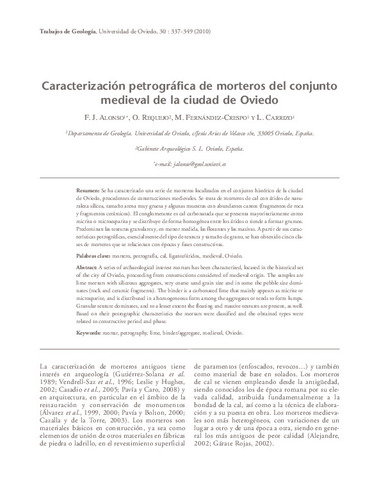Caracterización petrográfica de morteros del conjunto medieval de la ciudad de Oviedo
Palabra(s) clave:
Mortero
Petrografía
Cal
Ligante/Áridos
Medieval
Oviedo
Mortar
Petrography
Lime
Binder/Aggregate
Fecha de publicación:
Editorial:
Universidad de Oviedo, Departamento de Geología
Citación:
Descripción física:
Resumen:
Se ha caracterizado una serie de morteros localizados en el conjunto histórico de la ciudad de Oviedo, procedentes de construcciones medievales. Se trata de morteros de cal con áridos de naturaleza silícea, tamaño arena muy gruesa y algunas muestras con abundantes cantos (fragmentos de roca y fragmentos cerámicos). El conglomerante es cal carbonatada que se presenta mayoritariamente como micrita o microesparita y se distribuye de forma homogénea entre los áridos o tiende a formar grumos. Predominan las texturas granulares y, en menor medida, las flotantes y las masivas. A partir de sus características petrográficas, esencialmente del tipo de textura y tamaño de grano, se han obtenido cinco clases de morteros que se relacionan con épocas y fases constructivas.
Se ha caracterizado una serie de morteros localizados en el conjunto histórico de la ciudad de Oviedo, procedentes de construcciones medievales. Se trata de morteros de cal con áridos de naturaleza silícea, tamaño arena muy gruesa y algunas muestras con abundantes cantos (fragmentos de roca y fragmentos cerámicos). El conglomerante es cal carbonatada que se presenta mayoritariamente como micrita o microesparita y se distribuye de forma homogénea entre los áridos o tiende a formar grumos. Predominan las texturas granulares y, en menor medida, las flotantes y las masivas. A partir de sus características petrográficas, esencialmente del tipo de textura y tamaño de grano, se han obtenido cinco clases de morteros que se relacionan con épocas y fases constructivas.
A series of archaeological interest mortars has been characterized, located in the historical set of the city of Oviedo, proceeding from constructions considered of medieval origin. The samples are lime mortars with siliceous aggregates, very coarse sand grain size and in some the pebble size dominates (rock and ceramic fragments). The binder is a carbonated lime that mainly appears as micrite or microsparite, and is distributed in a homogeneous form among the aggregates or tends to form lumps. Granular texture dominates, and to a lesser extent the floating and massive textures are present, as well. Based on their petrographic characteristics the mortars were classified and the obtained types were related to constructive period and phase.
A series of archaeological interest mortars has been characterized, located in the historical set of the city of Oviedo, proceeding from constructions considered of medieval origin. The samples are lime mortars with siliceous aggregates, very coarse sand grain size and in some the pebble size dominates (rock and ceramic fragments). The binder is a carbonated lime that mainly appears as micrite or microsparite, and is distributed in a homogeneous form among the aggregates or tends to form lumps. Granular texture dominates, and to a lesser extent the floating and massive textures are present, as well. Based on their petrographic characteristics the mortars were classified and the obtained types were related to constructive period and phase.
Ficheros en el ítem




